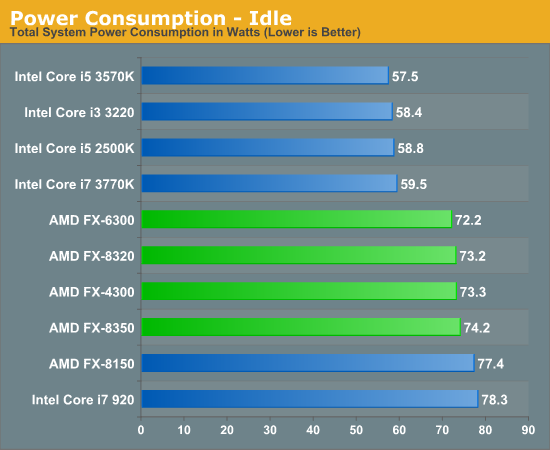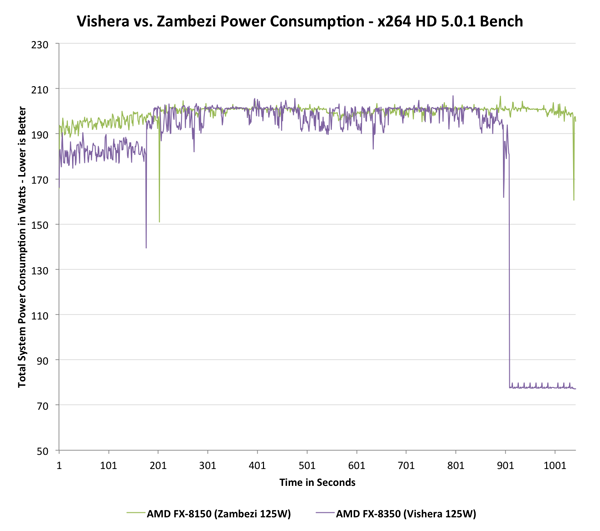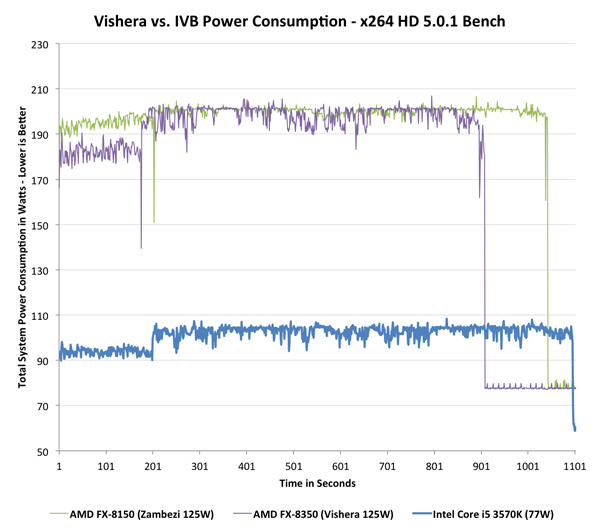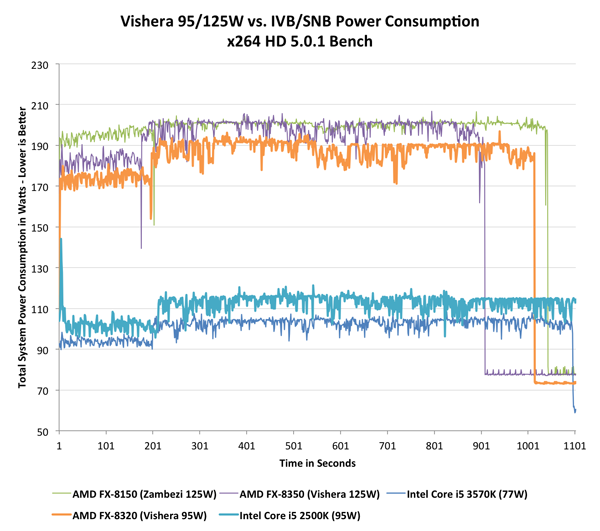The Vishera Review: AMD FX-8350, FX-8320, FX-6300 and FX-4300 Tested
by Anand Lal Shimpi on October 23, 2012 12:00 AM ESTPower Consumption
With Vishera, AMD was in a difficult position: it had to drive performance up without blowing through its 125W TDP. As the Piledriver cores were designed to do just that, Vishera benefitted. Remember that Piledriver was predominantly built to take this new architecture into mobile. I went through the details of what makes Piledriver different from its predecessor (Bulldozer) but at as far as power consumption is concerned, AMD moved to a different type of flip-flop in Piledriver that increased complexity on the design/timing end but decreased active power considerably. Basically, it made more work for AMD but resulted in a more power efficient chip without moving to a dramatically different architecture or new process node.
In mobile, AMD used these power saving gains to put Piledriver in mobile APUs, a place where Bulldozer never went. We saw this with Trinity, and surprisingly enough it managed to outperform the previous Llano generation APUs while improving battery life. On desktops however, AMD used the power savings offered by Piledriver to drive clock speeds up, thus increasing performance, without increasing power consumption. Since peak power didn't go up, overall power efficiency actually improves with Vishera over Zambezi. The chart below illustrates total system power consumption while running both passes of the x264 HD (5.0.1) benchmark to illustrate my point:
In the first pass Vishera actually draws a little less power, but once we get to the heavier second encode pass the two curves are mostly indistinguishable (Vishera still drops below Zambezi regularly). Vishera uses its extra frequency and IPC tweaks to complete the task sooner, and drive down to idle power levels, thus saving energy overall. The picture doesn't look as good though if we toss Ivy Bridge into the mix. Intel's 77W Core i5 3570K is targeted by AMD as the FX-8350's natural competitor. The 8350 is priced lower and actually outperforms the 3570K in this test, but it draws significantly more power:
The platforms aren't entirely comparable, but Intel maintains a huge power advantage over AMD. With the move to 22nm, Intel dropped power consumption over an already more power efficient Sandy Bridge CPU at 32nm. While Intel drove power consumption lower, AMD kept it constant and drove performance higher. Even if we look at the FX-8320 and toss Sandy Bridge into the mix, the situation doesn't change dramatically:
Sandy Bridge obviously consumes more than Ivy Bridge, but the gap between a Vishera and any of the two Intel platforms is significant. As I mentioned earlier however, this particular test runs quicker on Vishera however the test would have to be much longer in order to really give AMD the overall efficiency advantage.
If we look at average power over the course of the two x264 encode passes, the results back up what we've seen above:

As more client PCs move towards smaller form factors, power consumption may become just as important as the single threaded performance gap. For those building in large cases this shouldn't be a problem, but for small form factor systems you'll want to go Ivy Bridge.
Note that idle power consumption can be competitive, but will obviously vary depending on the motherboard used (the Crosshair Formula V is hardly the lowest power AM3+ board available):














250 Comments
View All Comments
CeriseCogburn - Tuesday, October 30, 2012 - link
Except we can probably agree amd will fail to meet their goal in most of these future cases and fail to meet it and be very late as well (cpu side after all and they suck at being on time) , so some sideways review with all the possible advantages in testing and text will need to be skewed toward the amd side ( and they will be) to be able to claim "amd met it's goal! "Let's face it, if amd meets some bare minimum "test" for "achieving that goal" in one single area, the review will claim "they accomplished it". Like the recent time amd released whatever it was a cpu or a vid card and they had a single or so instance of 5 or 10 PROMISED on the egg shelf the day of their declared release and we were told (yes here) "they did it !"
LOL
On the other side of the "perfectly legitimate 15% is an equal and fair equation of the future", we have Intel, that likely won't be late, and if so just barely, and has the cahunas and record to probably exceed their stated goals.
To be honest, the best I can do for amd is say I like their new cpu name " Steamroller !"
For some reason, and this is of course pure speculation, hopeful ESP, wimmin's intuition, or perhaps a desperate attempt to give them a break...but...
I think the name Steamroller indicates they will have a winner when that puppy comes out.
Yes, I think it's crazy as well, but what if I'm right ?
LOL
I might be absolutely correct.
ac2 - Monday, October 22, 2012 - link
I really like those graphs...Especially the Sysmark and Compile ones, which project Steamroller being ahead of Ivy Bridge, and of course clear wins for the multi-threaded ones.
I wish Anand had done a similar current->projection graph for power consumption as well, that would have been very useful.
* Fingers crossed *, I think (wish!) the next gen APUs, Steamroller + GCN + new process node will be a real winner for AMD assuming power envelop comes down to < 100W TDP across the board and delivery in 2013.
CeriseCogburn - Tuesday, October 30, 2012 - link
Isn't it interesting how when it comes to AMD, the fanboy will go to great lengths never before seen, never before done for any other product from any other entity ever, and I mean ever, and spend their time in pure speculation about the future, graph it out, get their hopes going, take a look at the futureville landscape - LOLIt's AMAZING.
Penti - Tuesday, October 23, 2012 - link
Just proves, as it would that there shouldn't be any AM3+ socket for AMD as there are no high-end processors and it doesn't even help for general computing, workstation and gaming performance that AM3+ has 8-core chips. If you want i3 performance and gaming why would you buy anything over FX4300? If you buy a chip like that why couldn't you and AMD just have gone with FM2 instead? Why not launch 8-core FM2 chips if you really want them in consumers hands? FM2 will get Steamroller, why not make sure it will be thriving as a platform instead of having two desktop platforms? I don't think AM3+ justifies it's existence, I don't really want it and it doesn't really bring anything. It just reminds me of the AM2/+ and AM3 Phenom II days and look dated. I understand that there is no hypertransport in the FM2 platform, but let workstation users just buy Opteron server chips. AMD still needs to up it's singlethreaded performance with about 50%.Mysteoa - Tuesday, October 23, 2012 - link
It is not so easy to make it for FM2. First they have to put the NB inside the CPU in the FX line, for it to work on FM2. That will require more space, power consummation and heat.Penti - Tuesday, October 23, 2012 - link
The NB has been inside the CPU since K8 (Athlon 64 / Opteron 2003). It's only a HT (or IO) to PCIe bridge and integrated GPU in Trinity, and they already have Piledriver in Trinity (only CPU for FM2) so what the hell are you talking about? It performs just the same and are more modern core for core. NB is just DRAM-controller and some registers. I see it more like LGA1155 is good enough for everything now days, so is FM2 despite not having 6 or 8 core CPUs, just having faster cpus is enough. You can bake, bind or layout faster processors for FM2 even adding the number of cores if you like. AM3+ chipset doesn't have PCIe 3.0 in the 990-series and don't seem to be getting it any time soon so why buy into that platform? Certainly isn't much more performing.Enthusiasts can use SR5670 and Opteron's. It's not like 990-series has USB3 support any way. Now, FM2 doesn't have PCIe 3 support either, but might support it in an upgrade. Which of course would require new CPU and new motherboards. On AM3+ it would require new motherboards with new chipset only. Don't think PCIe "2.1" is a hindrance though, and a new CPU would benefit greatly either way. It's just a list of things that adds on the "feels old" category.
ET - Tuesday, October 23, 2012 - link
So you want to block the upgrade path? If as you say the FX4300 is all that people need, they should go ahead and buy Trinity. I'm sure that AMD will also release Athlon CPU's for FM2 like they did with FM1 and Llano. But for people who want a higher end AMD CPU, perhaps to upgrade their old one, being able to use the same socket as the old one did is helpful. A stable platform is a good thing, and AM3+ motherboards have been on the market for a while. I just don't see the rationale behind junking it in favour of the socket-du-jour.Penti - Tuesday, October 23, 2012 - link
Naw, I would say just go with Socket C32 and Opteron derived products. It's an under utilized Socket any way. I don't want to give away choice, just have a more clean and sensible line for desktop. AM3+ just seems like an orphaned platform to put Bulldozer out there. So it has lost it's relevance. They should release higher-performing Trinity chips too is what I would argue for of course. Having four Sockets here doesn't make a lot of sense. Moving to C32 would enable enthusiast like board, cheaper workstation-boards with dual-socket too, i.e. two 8-core 4 module Piledriver chips. It has dual-channel DDR3 like the desktop platform's. Maybe even two higher clocked native 6-core variants would have been something. But they won't do it. Of course Intel doesn't need to counter with an enthusiast platform either.Mainstream platforms is where it's at. Having an upgrade path for two desktop platform's, different chipset's etc doesn't make a lot of sense right now.
SonicIce - Tuesday, October 23, 2012 - link
2nd paragraph: "Look beyond those specific applications however and Intel can pull away with a significantly lead."Dadofamunky - Tuesday, October 23, 2012 - link
With 16GB of RAM and eight threads, why aren't we seeing realistic VM-driven virtualization benchmarks? Honestly, this is a huge application area that remains ignored by AT in their core architecture reviews. Something I always look for and never find.